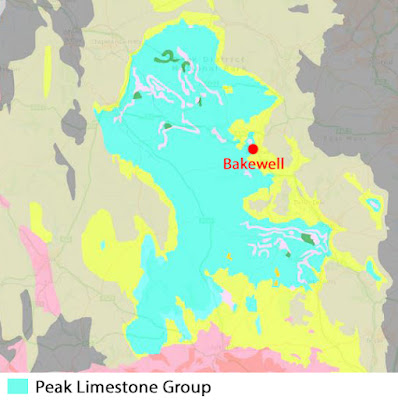Continuing my British Listed Buildings Photo Challenge for Ashford-in-the-Water, in the Peak District National Park, next on my list on Greaves Lane was a Grade II Listed late C18 pair of cottages - referred to by Historic England as ‘Clematis Cottage and adjoining cottage’.
Looking from the other side of the road, I assumed that the limestone walling included blocks of gritstone but, when examining my photos closely, it seems that that the orange colour is due to what is presumably iron staining of the grey micritic limestone. I don’t recall ever seeing anything like this before, but I assume that the bedrock from which it has been quarried is associated with some kind of mineralisation.
A little further up the road is the early C19 Ivy House, one of a semi-detached pair that is built with uniformly pale grey coloured limestone, which is well squared and coursed. All of the stone from the Carboniferous Limestone is difficult to work, with the micritic varieties from the dark facies of the Monsal Dale Limestone Formation (MDLF) having a conchoidal fracture, which makes it quite easy to recognise when it has been shaped into a building block.
When surveying the RIGS (Regionally Important Geological Sites) of the Peak District National Park for their ‘geotourism potential’ back in 1995, while living in Bakewell, I encountered nearly every formation in the Peak Limestone Group and passed through very many villages where the local limestone has been used for the vernacular architecture.
Also, during visits to several villages to see the mediaeval churches and photograph the associated historic buildings, I have since seen very many limestone built historic buildings. As with The Candle House, I suspect that the stone has been quarried some distance away from the light shelly shelf facies of the MDLF, but records of the quarrying in the area, including the Building Stones of England report and the accompanying Building Stones of England Database map explorer, are actually very poor.
An old village pump, which is surprisingly not listed, is incorporated into the field boundary wall just to the north of Ivy House and its enclosure is largely constructed in dark grey micritic limestone, which shows the distinctive conchoidal fracture where dressed to make coping stones that are used instead of the more traditional gritstone in places.
Opposite Ivy House is a small group of individually designed houses that are the work of Francis Cox-Wilson, built sometime after the 1922 edition (revised in 1919) of the Ordnance Survey map was published - which is the latest map of Ashford-in-the Water to be shown on the National Library of Scotland website.
They have an appearance that seem to be a last vestige of the Arts and Crafts movement, with limestone and gritstone, including a reddish variety, used in conjunction with roughcast render, brick and Tudor Revival style half-timbered gables and roofs made of plain red tiles – except for the terrace of three houses that includes Sunny Lea, which has a stone slate roof.
The early C19 Gritstone House, with its three storeys, is one of a few properties in the village that have the proportions of a town house and has finely tooled ashlar masonry, which was presumably supplied by one of the quarries working the Ashover Grit in the vicinity of Bakewell.
Walking further up Greaves Lane, I could only get glimpses of The Grange and the principal elevation of Taxus Hill, both of which are early C19 houses that are built with the now familiar coursed rubble limestone walling, gritstone dressings and stone slate roofs.
Continuing up the hill for a short distance, the difference between the limestone used in the gable end wall of Taxus Hill and the adjacent house fronting the road is quite noticeable, with the former being a mixture of micrite and thinly bedded light brown limestone containing beds of chert and the latter being uniformly grey in colour.
After walking back down the hill to the junction with Hill Cross, I stopped to take a couple of photos of Arncliffe House, which is not listed but its very steep Welsh slate roofs and cusped barge boards give it a very imposing appearance. Also, brown cherty limestone and uniformly grey limestone have been used for its south and north-east elevations respectively.













No comments:
Post a Comment